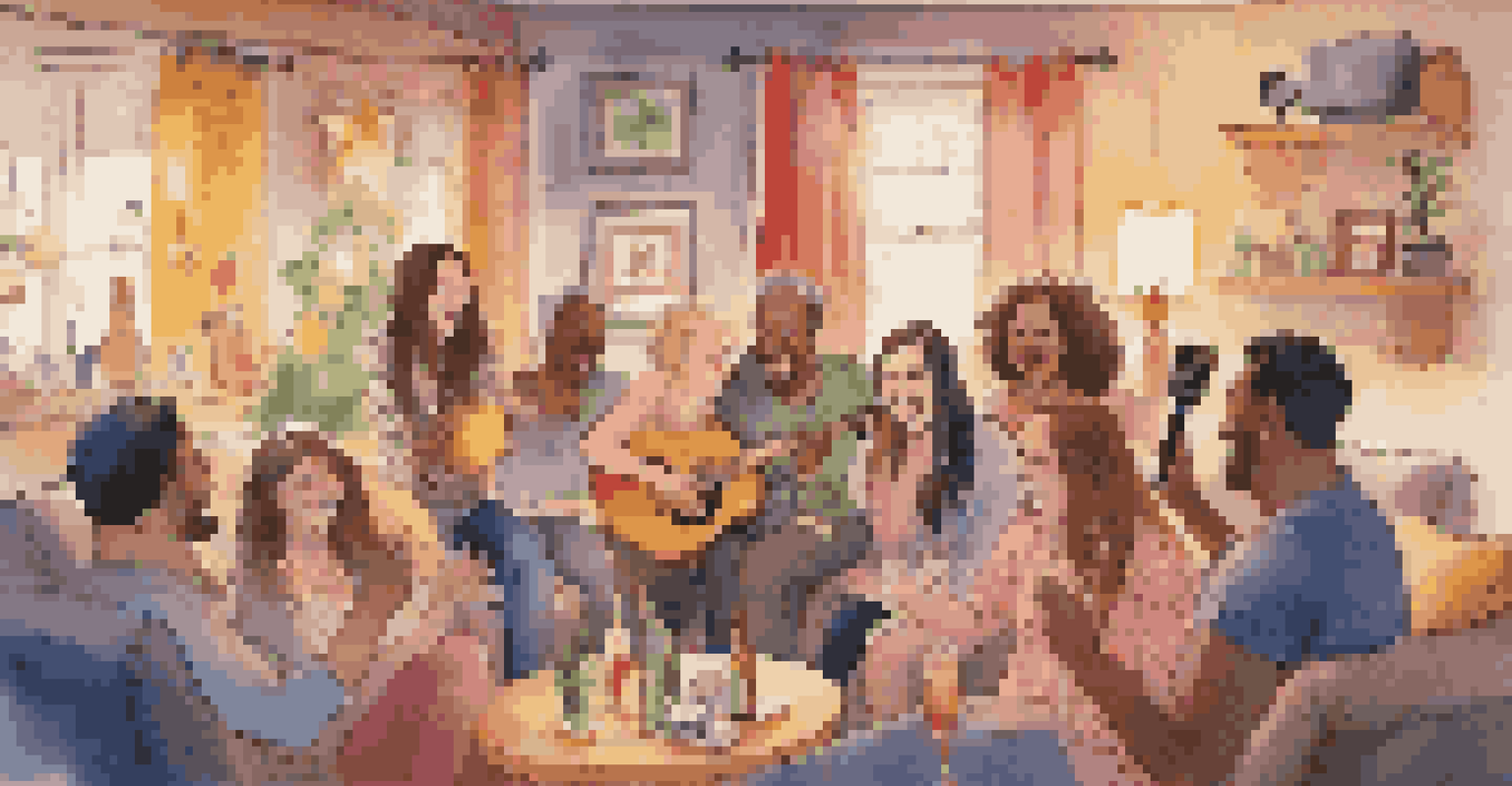How Music Enhances Social Interactions and Brain Function

Music as a Universal Language Connecting People
Music transcends cultural and linguistic barriers, allowing people to connect on a deeper level. Think about how a catchy tune can evoke emotions, regardless of where you come from. This shared experience fosters camaraderie and understanding among individuals, whether at a concert or just listening to a favorite playlist.
Music can change the world because it can change people.
When people come together to enjoy music, they often engage in conversations, share memories, and create lasting bonds. This communal aspect of music helps strengthen social ties, making it easier for individuals to connect and share experiences. It’s like a social glue that brings people closer, turning strangers into friends.
Moreover, music has the power to spark conversations and initiate connections that might not have happened otherwise. For example, two people might strike up a conversation about a shared favorite band, leading to a friendship built on common interests. In this way, music acts as a catalyst for social interaction.
The Science of Music and the Brain
Music engages multiple areas of the brain, enhancing cognitive functions such as memory and attention. When you listen to your favorite song, brain regions responsible for emotions, memory, and even motor control light up. This intricate interplay means that music can stimulate brain activity in a unique way, leading to various benefits.

Research has shown that music can improve learning and retention capabilities. For instance, students who study with background music often find it easier to remember information. This links back to the way music activates different brain areas, creating a dynamic learning environment that’s both enjoyable and effective.
Additionally, engaging with music—whether through playing an instrument or singing—can enhance neural connections. This means that regular musical activity not only makes the brain work harder but also keeps it healthy, much like exercise does for the body. So, picking up that guitar or joining a choir can be a workout for the mind!
Music and Emotional Expression in Social Settings
Music serves as a powerful medium for emotional expression, allowing individuals to convey feelings that words may not fully capture. This is particularly evident in social settings, where songs can set the mood and create an atmosphere of shared emotion. Whether it’s a wedding or a party, the right playlist can make all the difference.
Where words leave off, music begins.
In group settings, music can help individuals feel more connected by mirroring shared emotions. When everyone sings along to a beloved anthem, it creates a sense of unity and belonging. This shared experience can lead to heightened feelings of happiness, which further strengthens social bonds.
Moreover, music can help people process their own emotions and connect with others on a deeper level. For example, listening to melancholic music can stir feelings of nostalgia, prompting individuals to share personal stories. This exchange not only fosters intimacy but also promotes understanding and empathy among friends and family.
The Role of Music in Building Community
Communities often come together through music, creating a sense of belonging among diverse groups. Events like concerts, festivals, and community dances allow individuals to celebrate together, reinforcing social ties. These gatherings provide a platform for people to meet and interact, fostering a sense of unity and shared identity.
In many cultures, music plays a vital role in traditions and rituals, marking important life events. For example, folk music is often passed down through generations, preserving cultural heritage. This shared musical history not only strengthens community bonds but also instills a sense of pride and belonging among members.
Additionally, community music programs can serve to bridge gaps between different demographics. By bringing together people from various backgrounds, these initiatives promote inclusivity and understanding. Music, in this sense, becomes a tool for social change, fostering connections in diverse communities.
How Music Influences Group Dynamics
Music can significantly influence group dynamics, impacting how individuals interact and communicate. For instance, playing upbeat music in a team-setting can boost morale and encourage collaboration. This dynamic creates an environment that is not only productive but also enjoyable, fostering positive relationships among team members.
Moreover, shared musical experiences can help establish a sense of identity within a group. Whether it’s a sports team or a workplace, having a common anthem can strengthen bonds and create a feeling of belonging. This shared identity can enhance teamwork and collaboration, making the group more cohesive.
On the flip side, music can also impact mood and behavior negatively if the wrong genre is played. For example, playing aggressive music in a tense situation might escalate conflicts rather than promote harmony. Understanding the effects of different types of music is essential for creating positive social environments.
The Therapeutic Benefits of Music in Social Contexts
Music therapy has gained recognition for its ability to enhance social interactions and improve mental well-being. In therapeutic settings, music can help individuals express themselves, build trust, and form connections with others. This is particularly beneficial for those with social anxiety or communication challenges, providing a safe space for interaction.
Group music therapy sessions are especially effective in promoting social skills and reducing feelings of isolation. Participants often find comfort in sharing musical experiences, which can lead to increased self-esteem and improved social capabilities. The communal nature of these sessions fosters a sense of belonging, making participants feel less alone.
Furthermore, engaging in music-making activities can help individuals develop and reinforce social bonds. Whether through playing in a band or participating in a choir, these shared experiences create opportunities for collaboration and friendship. In this way, music becomes a powerful tool for healing and connection.
Finding Your Rhythm: Embracing Music for Social Growth
Incorporating music into your social life can enhance your interactions and create lasting memories. Whether it’s hosting a karaoke night or attending a local concert, these activities provide opportunities for connection and enjoyment. Embracing music as a social tool can help you forge new friendships and strengthen existing ones.
Consider exploring different music genres and attending various events to discover what resonates with you and your friends. This can lead to deeper conversations and shared experiences, enriching your social life. Plus, you might stumble upon new favorites that become part of your collective memory.

Ultimately, the magic of music lies in its ability to bring people together, create joy, and foster connections. So, don’t hesitate to turn up the volume and invite others to join in on the fun. After all, life is better when shared with a soundtrack!